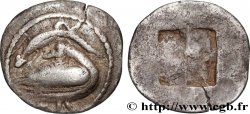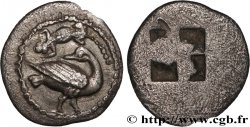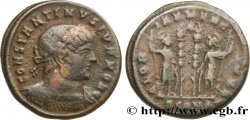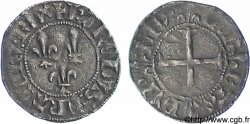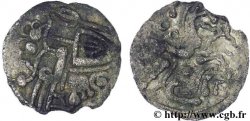v59_0068 - MACEDONIA - EION Trihemiobole
MONNAIES 59 (2013)
Prezzo di inizio : 380.00 €
Valutazione : 650.00 €
Prezzo realizzato : 510.00 €
Numero di offerte : 2
Offerta maxima : 567.00 €
Prezzo di inizio : 380.00 €
Valutazione : 650.00 €
Prezzo realizzato : 510.00 €
Numero di offerte : 2
Offerta maxima : 567.00 €
Tipo : Trihemiobole
Data: c. 500 AC.
Nome della officina / città: Eion, Macédoine
Metallo : argento
Diametro : 11 mm
Peso : 0,95 g.
Grado di rarità : R2
Commenti sullo stato di conservazione:
Exemplaire sur un flan ovale, finement détaillé de toute beauté servi par une magnifique patine de médaillier gris foncé avec des reflets dorés
N° nelle opere di riferimento :
Pedigree :
Cet exemplaire provient de la collection du docteur Thierry de Craeker
Diritto
Descrittivo diritto : Oie debout à droite, levant la patte gauche sur une base rectangulaire ornée de globules surmontée d’un globule annelé, tournant la tête à gauche ; au-dessus, un lézard.
Rovescio
Titolatura rovescio : ANÉPIGRAPHE.
Descrittivo rovescio : Carré creux quadripartite.
Commento
Exemplaire du monnayage le plus ancien d’Eion. Carré creux en aile de moulin. Il faudrait plutôt voir dans ce divisionnaire un trihemiobole qu’une diobole comme le fait l’ANS, vol 7, p. 11. Les poids très distendus vont de 1,17 g (Paris, BnF) à 0,80 g (ANS. 270). Au droit, l’oie est décrite comme étant sur une base et si tout simplement elle était en train de pondre des œufs.
Example of the oldest coinage of Eion. Hollow square in the shape of a mill wing. This divisionary should be seen more as a trihemiobolus than a diobolus as does the ANS, vol. 7, p. 11. The very distended weights range from 1.17 g (Paris, BnF) to 0.80 g (ANS. 270). On the obverse, the goose is described as being on a base and as if it were simply laying eggs.
Example of the oldest coinage of Eion. Hollow square in the shape of a mill wing. This divisionary should be seen more as a trihemiobolus than a diobolus as does the ANS, vol. 7, p. 11. The very distended weights range from 1.17 g (Paris, BnF) to 0.80 g (ANS. 270). On the obverse, the goose is described as being on a base and as if it were simply laying eggs.








 Segnalare un errore
Segnalare un errore Stampate la pagina
Stampate la pagina Condividi mia selezione
Condividi mia selezione Fai una domanda
Fai una domanda Consegnare / vendere
Consegnare / vendere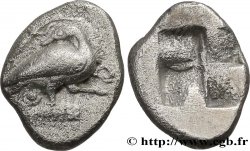
 Descrittivo
Descrittivo
